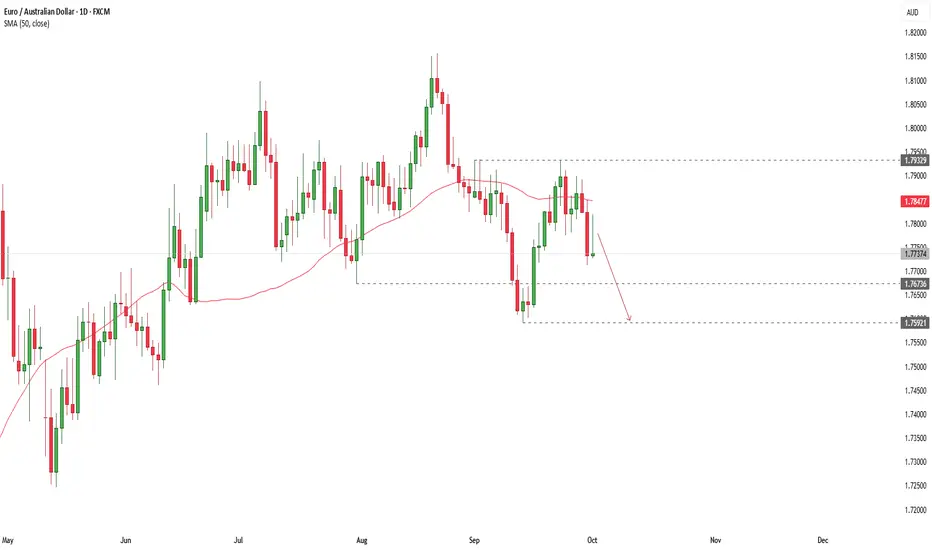Now that we have the 30 Sept 2025 RBA statement, here’s a side-by-side comparison with the prior (August) statement, highlighting the specific new remarks, data changes, and tone shifts that matter for markets in the short term.
Key Differences: September vs August
Tone shift: Compared to August, the September statement is less dovish. It highlights stronger domestic demand, slower disinflation, and sticky unit labor costs.
Implication: This reduces near-term probability of another immediate cut. Markets may pare back November cut expectations slightly.
AUD reaction: Near term (this week and next), AUD likely supported on dips, especially if global risk sentiment doesn’t collapse. AUD currency crosses may see AUD outperformance, while AUDUSD may remain also supported but also more dependent on USD drivers.
Unless we see a major surprise from U.S. Jobs data I will remain short with minimum target at 1.7593
If you have any questions don't hesitate to drop them in the comments below.
Key Differences: September vs August
- Inflation
August: Inflation had eased into the 2–3% band, with underlying momentum lower, helped by rebates and easing pressures.
September: “The decline in underlying inflation has slowed… recent data suggest Q3 inflation may be higher than expected.”
🔹 New: Clearer warning that disinflation is stalling, with upside surprise risk. This is a hawkish tilt, raising doubt about how quickly the RBA will cut again. - Domestic demand & growth
August: Growth outlook was subdued, public demand dominant, consumption weak, risks tilted to downside.
September: “Private demand is recovering… private consumption is picking up as real household incomes rise… housing market is strengthening.”
🔹 New: Stronger domestic recovery narrative. This is a shift away from a purely dovish, weak-growth picture, suggesting easing might not need to be as aggressive. - Labor market
August: Labor conditions softening somewhat, unemployment ~4.3%, some easing in demand.
September: “Labor market conditions broadly steady… unemployment unchanged at 4.2%, underutilization low… wages growth has eased, but productivity weak and unit labor costs high.”
🔹 New: Balanced message — employment growth slowed, but overall labor market remains tight. The mention of unit labor costs high is a hawkish insertion, as it points to sticky wage-price dynamics. - Global risks
August: Emphasized uncertainty, trade headwinds, geopolitical risks, downside to global demand.
September: “More clarity on US tariffs — extreme outcomes avoided, but still adverse effect expected… geopolitical risks remain.”
🔹 New: Slightly more optimistic (less extreme trade risks), but still cautious. Market read: less urgent downside risk, neutral for AUD. - Policy stance / guidance
August: Dovish, emphasized “data dependency,” readiness to act, conditional forward guidance.
September: “Signs that demand is recovering, inflation may be persistent in some areas, labor market stable… appropriate to remain cautious… policy well placed to respond if needed.”
🔹 New: Stronger caution against rushing into more cuts. Less dovish than before, reinforcing a wait-and-see bias.
Tone shift: Compared to August, the September statement is less dovish. It highlights stronger domestic demand, slower disinflation, and sticky unit labor costs.
Implication: This reduces near-term probability of another immediate cut. Markets may pare back November cut expectations slightly.
AUD reaction: Near term (this week and next), AUD likely supported on dips, especially if global risk sentiment doesn’t collapse. AUD currency crosses may see AUD outperformance, while AUDUSD may remain also supported but also more dependent on USD drivers.
Unless we see a major surprise from U.S. Jobs data I will remain short with minimum target at 1.7593
If you have any questions don't hesitate to drop them in the comments below.
Clause de non-responsabilité
Les informations et les publications ne sont pas destinées à être, et ne constituent pas, des conseils ou des recommandations en matière de finance, d'investissement, de trading ou d'autres types de conseils fournis ou approuvés par TradingView. Pour en savoir plus, consultez les Conditions d'utilisation.
Clause de non-responsabilité
Les informations et les publications ne sont pas destinées à être, et ne constituent pas, des conseils ou des recommandations en matière de finance, d'investissement, de trading ou d'autres types de conseils fournis ou approuvés par TradingView. Pour en savoir plus, consultez les Conditions d'utilisation.
